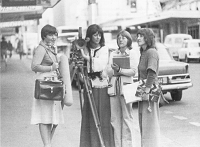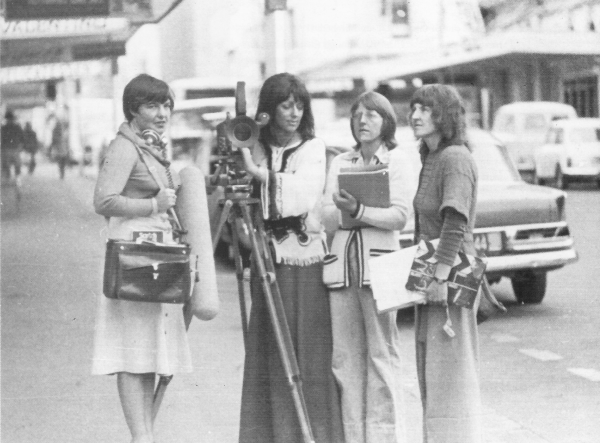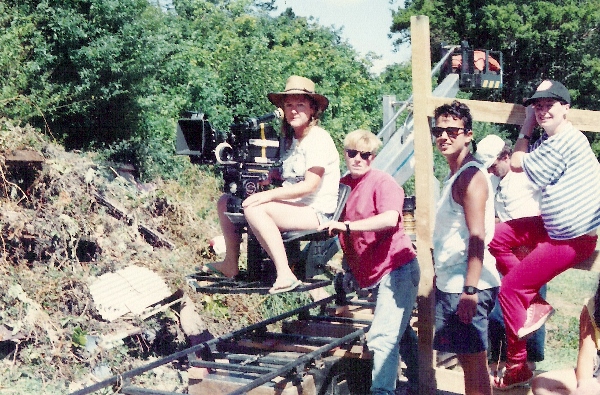 Representing NZCS on the selection panel for the inaugural Cinefem scholarship caused cinematographer Mairi Gunn to reflect on her own career. It’s a story involving focus pulling, shooting while pregnant, balancing family life and winning awards, intertwined with the history of camerawomen in New Zealand.
Representing NZCS on the selection panel for the inaugural Cinefem scholarship caused cinematographer Mairi Gunn to reflect on her own career. It’s a story involving focus pulling, shooting while pregnant, balancing family life and winning awards, intertwined with the history of camerawomen in New Zealand.


Womens’ Series (1976) L-R Lorraine Engelbretson (sound recordist), Margaret Moth (camera), Julie Thomson (research) and Deidre McCartin (director). Deborah Shepard from Reframing Women: A History of New Zealand Film (Auckland: Harper Collins, 2000: 52)
In 1932 Hilda Hayward, Rudall Hayward’s first wife, picked up her camera and went to film the Auckland riots in Queen Street. It was a courageous move that made her New Zealand’s first known camerawoman and paved the way for women who have been working with movie cameras in New Zealand ever since. Hayward had previously collaborated with her husband as an editor but went on to shoot doco and drama footage with, and without him.
Later, Ramai Hayward, Rudall Hayward’s second wife, and Margaret Moth became icons for aspiring women cinematographers. Ramai is credited as the first Maori camerawoman. She was a stills photographer with her own photographic studio in Devonport before she met Rudall. Margaret left New Zealand after shooting The Women’s Series in 1976 and became a renowned CNN news and current affairs shooter. Both have since passed away.
Only one other woman
Despite this history, in 1984, after four years in the cutting room, I joined the camera department in the New Zealand freelance film and television industry. There was only one other female camera assistant working on drama shoots. Her name was Moi Cameron and she later became a firewoman.
It is quite surreal being the only one of something. It defies reason and the isolation is problematic for a collaborative person. Thankfully, in 1988, Merata Mita invited me to a wānanga with her filmmaking buddies such as Annie Collins. It was to support Sharon Hawke and others to fulfil their roles on the upcoming Manuka series with the legendary Don Selwyn. Subsequently Josie Harbutt was working on film shoots in the 1990s and I was on Black Beauty with Rewa Harré on Kirsten Green’s first day as a loader. There was Rachel Baird, Rachel Douglas, Amanda Clark, Freddie, Tara Landry and many more stalwart women loading and pulling focus after I moved from fiction to the documentary genre. And there were still more talented women who chose not to go on become cinematographers for a myriad of reasons.
Too hard
 I meet women everywhere, often behind desks, or as editors, who say they wanted to become a camerawomen but it had seemed too hard. They had the impression it might be too physically taxing, which was a perception at the time, or too psychologically challenging due to impending torment from some careless cowboys – the men who could sway attitudes and atmospheres on set. Others identified unsupportive attitudes within the female dominated production office as a potential drag on their emotional resources. This was a pity because the right mentors can provide crucial support to overcome perceived and real obstacles.
I meet women everywhere, often behind desks, or as editors, who say they wanted to become a camerawomen but it had seemed too hard. They had the impression it might be too physically taxing, which was a perception at the time, or too psychologically challenging due to impending torment from some careless cowboys – the men who could sway attitudes and atmospheres on set. Others identified unsupportive attitudes within the female dominated production office as a potential drag on their emotional resources. This was a pity because the right mentors can provide crucial support to overcome perceived and real obstacles.
Back then I was operating with film cameras – Super 8, 16mm Bolex, Aaton or ARRI 16BL – using no more than a couple of lights or a ship’s flare and often working almost alone with a director, although Chris Plummer reminded me that he held a lamp for me while filming in the bombed out Rainbow Warrior in 1985.
This was my shooting life in parallel to the mainstream industry where I was a camera assistant. I loved the physicality of being an assistant, along with the banter, the precision, the travel and adventures (even though the pressure was sometimes untenable and the osteopath became a friend).
Just me
I did it for ten years until my mother suggested I stop serving others and just shoot. That was in 1995, and she gave me that advice the year she died. My main mentor was gone. I was not one of a filmmaking dynasty or part of any other team – I was just me. I had been shooting since about 1980 – around twenty short films, a bunch of music videos, some docos and one 16mm feature film, Gravity and Grace. It was about time to call myself a cinematographer.
I joined WIFT for collegial support and access to an international arena because there was no cinematographer’s society back then. I didn't know I'd have to wait 12 years to become a foundation member of the NZCS.
Roaring success
It was twenty years after I joined the industry that I met my first female cinematographer, Australian Jan Kenny, and organised a WIFT weekend cinematography workshop with her. The weekend was a roaring success. Camerawomen Sharon Hawke and Ginny Loane were there. Ginny had been working in the lighting department and was a rising star then, while today she is a role model for the new generation of aspiring female cinematographers.
Since then, Jac Fitzgerald appeared on the scene and has been shooting drama and TV commercials. So, there were only a handful of us who had come up through the celluloid years. Strangely that was perceived by some as an entire platoon, commenting ‘There are lots of you now, aren’t there!’. Yet in reality there were so few women out of more than a hundred shooters. It was a matter of perception. The few stood out in high relief.
 Operating on Timetrap (1990) with Erin O'Leary, Therese Mangos, Rick Allender and Sally Smith (director/writer)
Operating on Timetrap (1990) with Erin O'Leary, Therese Mangos, Rick Allender and Sally Smith (director/writer)
Shooting pregnant
I’d shot the 16mm feature Gravity and Grace (1994) in Auckland and NY before I met my partner Mike on a Wellington production to do with domestic violence (it won me the ITVA camera award in 1995). Some productions are extra lucky. Mike and I shot and recorded my second feature, Harold Brodie’s Reality Show then we went to Ireland while I was pregnant to shoot and sound record Shirley Grace’s Erin’s Exiled Daughters. Bridie was born in 1997. After that, there were about five more short films including Felicity Morgan Rhind’s Donuts for Breakfast which screened at the New York Film Festival, amongst others.
I felt that I really needed to establish myself as a cinematographer before I had a baby. I sensed that a baby would change things and I was right. Short form drama and docos were just manageable but not the big drama shoots. I didn’t want to put stress on my daughter. I remember throwing my breast milk out the window of a moving car on the way to a recce in Piha because my baby wasn’t around to relieve the pressure naturally!
Some shoots, like Donuts for Breakfast, Bridie attended because Mike could stay with us on location. She was sick during Moby’s Island so considerate crew members carried her along the beach to keep her within eyeshot. She had her own wee department. Since I have no family close by, a change of schedule always necessitated some domestic production management on my part. I only recently learned that there is an aversion to hiring mothers in key roles because of our changed priorities.
Bummer
I waited and waited to shoot a TV drama like so many of the great ones I had pulled focus on. However, there was about an eight-year drought. Bummer. Then when Mike and I were filming a doco in the US in 2001, I was able to accompany Donuts for Breakfast to Sundance. I was embraced by the doco community there and gravitated to the House of Docs, a space for panel discussions and screenings that was dedicated to documentaries. What a relief to see that the inclusive Errol Morris had his entire Interrotron crew on the podium beside him, explaining their shooting process to the audience. It was a revelation to discover a world where ideas and real people matter more than cool, career, or celebrity. I was converted. My work with factual storytelling has since led me into the field of video installation, where computers and digital imagery reign – a brave new world with almost unlimited potential.
Shedding trucks
In the past the scale of the equipment generally involved trucks. But now working with the newer, lighter weight digital cameras we are shedding the trucks and the budget! The arrival of DSLRs has democratised the medium and helped to increase the number of female shooters.
Coupled with that is the proliferation of cameras throughout almost every aspect of our lives plus the proclivity for content that many students and 48 hour pundits are happy to supply at low cost or gratis. Working in the gift economy requires optimism and energy. That’s something our young women have in spades. In addition to developing their craft, they practice their sports, build their own companies, go to art school – or go to Brazil and shoot thrilling dance movies as one of the Cinefem Scholarship applicants did. And women from all over the world have come to us. Maybe it is the worldwide fame of Weta that attracts them, or our reputation as a liberal, green society that first gave women the vote.
Power of diversity
I believe strongly in the power of diversity to enrich our ways of being and working in the world, and initiated the informal Slow Film Movement as a counterpoint to the dollar-driven, slavish, six or seven-day week. Now owning our own gear is within our reach it means that we can be more flexible. We can avoid the costs of equipment hire, the time pressure and inhuman work schedules. Women can and are devising new ways of working. These new approaches impact on the kind of films that can be made and the stories that can be told.
Recently, I have detected a sea change for women with cameras. This was very evident at a recent WIFT/NZCS evening at Panavision. Women pretty much ran the show. It was an historical moment. Aliesha Staples held the floor as she introduced various drones and gimbals to an audience that included old hands and newbies, both male and female. The evening was electric.
Scholarship
In April of this year, I was invited to film a series of interviews of our women filmmakers for a New Zealand Film Commission initiative supported by Jane Campion. Jane’s comments about the woeful lack of women in film internationally – she is still the only woman to have won the coveted Cannes Palme d’Or – have galvanised the Film Commission into positive action. Together they devised the Cinefem Scholarship as a way of supporting women filmmakers and New Zealand film culture in general. The first scholarship focused on cinematography, and Ginny Loane and I represented NZCS on the selection panel along with Richard Bluck. I was struck by the combined experience of the applicants, the quality and diversity of the work and the high standard. We were keenly aware that there were very few Maori and Polynesian applicants, but were pleased that pregnant women and mothers applied for this cinematographers’ scholarship.
I believe there is an abundance of talent and commitment in New Zealand and that as a group, women in film have a great deal to offer. I am encouraged by the possibilities offered by the new media and by the passion of the younger generations and their work ethic. It is a world of talent and opportunity that the pioneers Hilda Hayward, Ramai Hayward and Margaret Moth would probably find difficult to believe and I think it should give us cause for optimism about the future.
Maria Ines Manchego wins cinematography opportunity